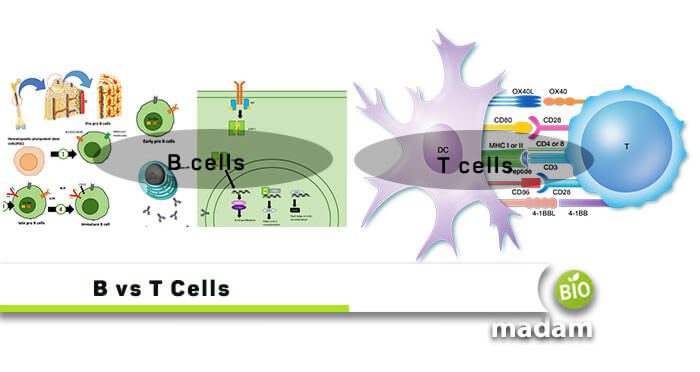Every living body is grown with a specific immune system that helps fight against deadly microorganisms or other infections. Among many others, lymphocytes are the immune system cells that play a crucial role in protecting a body. They are spread in the circulating white blood cells in 20 to 40 percent, whereas the lymph contains 99%. Lymphocytes are further specialized into three cells such as:
- B lymphocytes (B cells)
- T lymphocytes (T cells)
- Natural Killer (NK) cells
B and T cells are small, almost 8–10 microns in diameter, having a large nucleus with a dense heterochromatin structure. Both these immune cells can recognize and respond specifically to antigens. Although B and T cells appear identical under a student microscope, they still have some prominent differences that we’ll discuss today. These cells variably express the surface proteins, also referred to by the cluster of differentiation (CD or cluster of designation). The key difference between them is that B cells can immediately detect the bacterial or viral surface antigens whereas, T cells only recognize viral antigens outside the targeted cell.
Comparison Chart
| Basis of Comparison | B Cells | T Cells |
|---|---|---|
| Origin | Bone Marrow | Bone Marrow |
| Maturation | Spleen (initially) & naïve B cells (final maturation) | Thymus |
| Membrane Receptor | BCR | TCR |
| Life Span | Short | Long |
| Surface Antibodies | Present | Absent |
| Types | Memory Cells, Plasma Cells | Cytotoxic T Cells, Helper T Cells, Suppressor T Cells |
| Position | External to Lymph Node | In the Lymph Node |
| Secretion | Antibodies | Lymphokines |
| Immunity | Involved in Humoral Immunity | Involved in Cell- Mediated Immunity |
| Space of Blood Occupied | 20 percent | 80 percent |
What are B Cells or B Lymphocytes?
B cells are also called B lymphocytes, primarily matured from the site Bursa of Fabricius in birds. The primary organ from where the B cells of humans (mammals) develop is the bone marrow, but it, later on, differentiates in the fetal liver. These special cells display receptors called the B-cell receptor (BCR). Such receptors are membrane-bound immunoglobulin (antibody) molecules binding to specific antigens. Moreover, B lymphocytes have particular markers on them, called the B220 (CD45), that remains throughout the life span of B cells. Mature B cells express receptors for the compliment, such as
- CR1 (CD35) binds to the C3b
- CR2 (CD21) binds to the C3d
The Function of B Lymphocytes
A part of immune system, B cells or B lymphocytes produces antibodies and are also the center of adaptive humoral immunity. These specialized cells bind with the antigen to inactivate or kill them through a process known as somatic hypermutation. It further helps to improve its binding ability. Besides, the B lymphocytes generate two responses, namely primary and secondary. The former processes through the naïve B cells, while the latter follows the memory B cells.
Plasma Cells: B cells differentiate into effector cells called plasma cells that make many antibodies. They lose expression of surface immunoglobulin. A single plasma cell can secrete from a few hundred to more than a thousand antibody molecules per second. They secrete one of the five types of antibody that are IgA, IgD, IgM, IgG, and IgE.
Memory Cells: They don’t secrete antibodies but are cells that respond more rapidly and effectively to pathogens that have been encountered previously.
What are T Cells or T Lymphocytes?
Another lymphocytic cell type is the T cells, derived and developed from the thymus. It has the membrane receptors for antigen, called the T cell receptors or TCR. T cells receptors only recognize antigens when processed by antigen-presenting cells (APS) and bound by the Major Histocompatibility Complex (MHC). The first marker of T cells is Thy-1, which appeared during the maturation of T cells. Other markers of T cells are CD4 and CD8.
Types of T Cells
T cells are divided into two principal cells:
- T Helper (TH) Cells
- T Cytotoxic (TC) Cells
- Suppressor T Cells
T cells that display CD4 cells function and recognize antigen complex with MHC class II. Right after the antigen complex binds with MHC II, they become active, proliferate and differentiate into effector T cell subset
T Helper Type 1 (TH 1) Cells: TH 1 regulates immune responses against intracellular pathogens.
T Helper Type 2 (TH 2) Cells: TH 2 regulates immune responses against extracellular pathogens.
T Helper Type 17 (TH 17) Cells: TH 17 helps to provide defense against the fungi and secretes the IL-17.
T Follicular Helper Cells (TFH): TFH regulates B cells development in the germinal center and plays an influential role in humoral immunity. which can be active or passive.
Now the second type,
T Cytotoxic (TC) Cells: T cells that display CD8 cells function as these cells and recognize antigen complex with MHC class I. They have a vital function in monitoring the cells of the body. Cytotoxic T cells eliminate all those that display foreign antigen complex with MHC class I.
Differentiate between B and T Cells
Let’s head towards the differences between the two immunity cells.
Maturation & Origination
B Cells
These cells originate and mature; both at the same place, bone marrow, but when explicitly talking about birds, B cells originate from the Bursa of Fabricius.
T Cells
On the contrary, T cells originate from the same bone marrow but complete their maturation activities in the thymus.
Distribution of Cells
B Cells
These cells, when matured, are usually present in the external regions of lymph nodes, respiratory tract, spleen, gut, and the medullary or sub-capsular cords of lymph nodes.
T Cells
In contrast, T cells occur in the parafollicular areas of the cortex in the lymph nodes. Besides, these can be present in the periarteriolar region of the spleen.
Further Sub-Types/Types of Cells
B Cells
These are naturally differentiated into memory cells and plasma cells.
T Cells
T Lymphocytes are further divided into cytotoxic T cells, suppressor T cells, and helper T cells.
Main Role
B Cells
The primary function of B cells is to detect foreign particles (antigens) and develop beneficial antibodies against them.
T Cells
On the other hand, T cells detect the presence of microorganisms in a living body through the unique antigens on their surfaces.
The Difference in Membrane Receptors
B Cells
The special membrane receptors of B cells are called BCR receptors. Moreover, they have surface receptors too.
T Cells
On the other hand, T cells have receptors called TCR, but they lack surface receptors.
Surrounding Space in Blood
B Cells
B cells have an approximate 20% area consumed in the lymphocytes, present in the blood.
T Cells
Whereas the remaining 80% of the space is occupied by the T cells in the blood.
Life Span
B Cells
Mature B lymphocytes have a comparatively shorter life span, from a couple of days to a week.
T Cells
On the contrary side, mature T cells usually live longer, which can prolong from a couple of days to multiple weeks.
Type of Immunity Involved and its Function
B Cells
These carry humoral-mediated immunity, also called antibody-mediated immunity (AMI). In such immunity mechanisms, the cells secrete antibodies to identify the surface antigens of microbes; moreover, these fight to save the body from these deadly microorganisms, bacteria, or viruses.
T Cells
In contrast, these cells carry the cell-mediated immunity (CMI), where they secrete lymphokines to move to the infected area and perform an action. T lymphocytes function to process against any transplanted organ or a cancerous cell. Besides being the immunity cells, these also fight against different microbes entering a body.
Summary
Whether it’s the B lymphocytes or T cells, both function to boost our immunity and fight against harmful foreign particles. The main difference between B cells and T cells is identifying a microorganism. B cells secrete specific antibodies, whereas the T cells detect surface antigens of microbes.

Anna has completed her degree in Pharmacy from the University of Hawaii. She is serving as a research assistant in a pharmaceutical company. She had a great interest in writing blogs, traveling to different parts of the US, and trying delicious recipes in her spare time.

